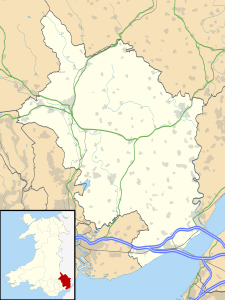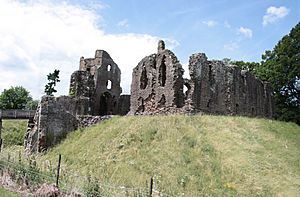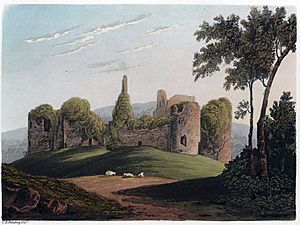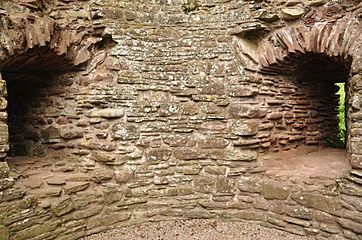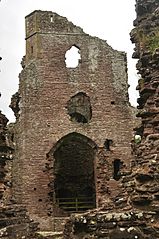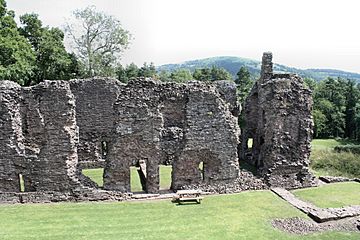Grosmont Castle facts for kids
Quick facts for kids Grosmont Castle |
|
|---|---|
| Grosmont, Monmouthshire, Wales | |
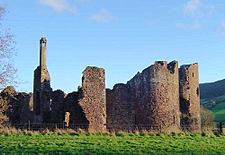
Grosmont Castle, seen from the north-west
|
|
| Coordinates | 51°54′55″N 2°51′57″W / 51.915278°N 2.865833°W |
| Type | Castle |
| Site information | |
| Controlled by | Cadw |
| Open to the public |
Yes |
| Condition | Ruined |
| Site history | |
| Materials | Old Red Sandstone |
| Events | Norman invasion of Wales Glyndŵr Rising |
|
Listed Building – Grade I
|
|
Grosmont Castle is a ruined castle in the village of Grosmont, Monmouthshire, Wales. It was built by the Normans after they invaded England in 1066. The castle helped protect a key route from Wales to Hereford.
At first, Grosmont Castle was made of earth and wood. In 1135, a big Welsh uprising happened. Because of this, King Stephen grouped Grosmont Castle with two nearby castles. These were Skenfrith and White Castle. Together, they were known as the "Three Castles". They helped defend the area from Welsh attacks for many years.
King John gave the castle to Hubert de Burgh in 1201. Over the next few decades, the castle changed hands many times. Hubert rebuilt parts of the castle using stone. He added a new hall, strong walls, a gatehouse, and towers. In 1233, a royal army camping near the castle was attacked by rebels. Edmund, the Earl of Lancaster, took over the castle in 1267. It stayed with his family until 1825.
When Edward I conquered Wales in 1282, Grosmont Castle became less important for defence. However, it was attacked in 1405 during the Glyndŵr Rising. By the 1500s, the castle was no longer used and fell into ruin. Today, Cadw, a Welsh heritage group, looks after the castle.
Contents
Grosmont Castle: A Look Back in Time
Building a Castle: The Norman Era
Grosmont Castle was built after the Normans conquered England in 1066. The Normans quickly moved into the Welsh borderlands. William the Conqueror made William fitz Osbern the Earl of Hereford. The Earl then captured Monmouth and Chepstow.
The Normans built many castles to control the Welsh lands. Castles helped them create new towns and show their power. Grosmont was one of three castles built in the Monnow valley. They protected the road from Wales to Hereford. The Earl might have built them himself.
The first castle at Grosmont was made of earth and wood. It had a keep and a motte (a raised mound). A wooden fence and a ditch protected it. The Normans also built a small town next to the castle. This town later became the village of Grosmont.
Who Owned the Castle? Changing Hands
The Earl's lands were split up after his son rebelled in 1075. By the early 1100s, Pain fitzJohn owned Grosmont. In 1135, a big Welsh revolt started. King Stephen then put Grosmont and its two sister castles, Skenfrith and White Castle, under royal control. They became known as the "Three Castles."
Fighting with the Welsh continued. In the 1170s, some powerful families attacked their Welsh rivals. This led to a Welsh attack on Abergavenny Castle in 1182. The Crown prepared Grosmont for a possible Welsh attack. About £15 was spent on the castle over three years. This money likely paid for work on the wooden defences.
Stone Walls and Royal Power: The 13th Century
In 1201, King John gave the "Three Castles" to Hubert de Burgh. Hubert was a rising official in the King's court. He started to improve his new castles, beginning with Grosmont. He rebuilt the hall block using stone.
Hubert was captured in 1205 while fighting the French. King John took back the castles and gave them to William de Braose. Later, King John fell out with William. William's son, also William, took the castles back during a time of war.
Hubert regained power and became a top royal official. He got the Three Castles back in 1219, during the reign of Henry III. He continued his work at Grosmont. He replaced the wooden walls with stone. He also added three mural towers and a gatehouse for defence. This made the castle a strong and fancy place to live.
Hubert lost power in 1232. The castles were taken from him. In 1233, King Henry led an army into Wales. They camped outside Grosmont Castle. A rebel leader, Richard Marshall, attacked them at night. The King's army had to flee, though the castle itself was not taken.
Hubert made up with the King in 1234 and got the castles back. But he fell out with King Henry III again in 1239. Grosmont was taken back and given to Walerund Teutonicus. Walerund finished some of Hubert's work, including building a new chapel.
In 1254, Grosmont Castle and its sister castles were given to King Henry's son, Edward. The Welsh threat continued. In 1262, the castle was prepared for attack. Its commander was told to defend it "by every man, and at whatever cost." Luckily, no attack happened.
Later Years and Ruin: 14th to 17th Centuries
Edmund, the Earl of Lancaster, received the Three Castles in 1267. For many centuries, these castles belonged to the powerful Lancaster family. When King Edward I conquered Wales in 1282, Grosmont Castle was no longer as important for defence.
However, the castle's inside was updated in the early 1300s. This made it a very comfortable home. A deer park was also kept around the castle.
The castle's last military role was during the Owain Glyndŵr revolt in the early 1400s. A battle took place near Grosmont in 1404, which the English won. The castle was attacked in 1405 by Owain's son, Gruffudd. But an English force, led by Prince Henry, saved the castle.
By 1538, Grosmont Castle was no longer used and became a ruin. A survey in 1563 noted that its bridge had fallen down. The outer walls were still standing, but the inside was decaying. A description from 1613 called it "ruynous and decayed."
Modern Times: Preservation and Care
In 1825, the Three Castles properties were sold to Henry Somerset, the Duke of Beaufort. In 1902, the 9th Duke sold Grosmont Castle to Sir Joseph Bradney, a local historian.
In 1909, reports said that Grosmont was very well cared for. In 1922, Frances Lucas-Scudamore put the castle under state care. Conservation work began, including clearing out debris. Today, Cadw, the Welsh heritage organization, manages Grosmont Castle. It is a protected historic site.
Castle Design: What It Looked Like
Grosmont Castle sits above the village of the same name. Its current look mostly comes from the work done by Hubert de Burgh. Later changes were made in the 14th century.
The castle originally had an inner and an outer ward. The outer area has now been taken over by local gardens. The outer ward likely held a rectangular storage building or stable. The inner ward is a stone castle. It has a gatehouse, two round towers, a hall, and a north living block. A ditch protected the whole castle.
Other wooden buildings would have been built against the outer stone wall. These were for the castle's servants. Only small traces of these buildings remain today.
The gatehouse was once a two-story, rectangular tower. It had a drawbridge pit added in the 14th century. Only small parts of it are left now. The south-west tower became a three-story set of rooms in the 14th century. Its basement was filled in. The three-story west tower was also changed in the 14th century, and its basement filled.
The north block was mostly added in the 14th century. It was built over an old round tower and a back gate. It has three separate buildings. The largest is a three-story living tower. This block has a special octagonal chimney with a carved top.
The hall block is a two-story building, about 96 by 32 feet. It had a spiral staircase connecting the floors. The first floor had the main hall and a solar room. A wooden wall separated them. The hall had a fireplace and two large windows. The ground floor had two service rooms with narrow windows. A wooden staircase outside led directly into the main hall. This hall would have looked much like Hubert de Burgh's hall at Christchurch Castle.
Images for kids


